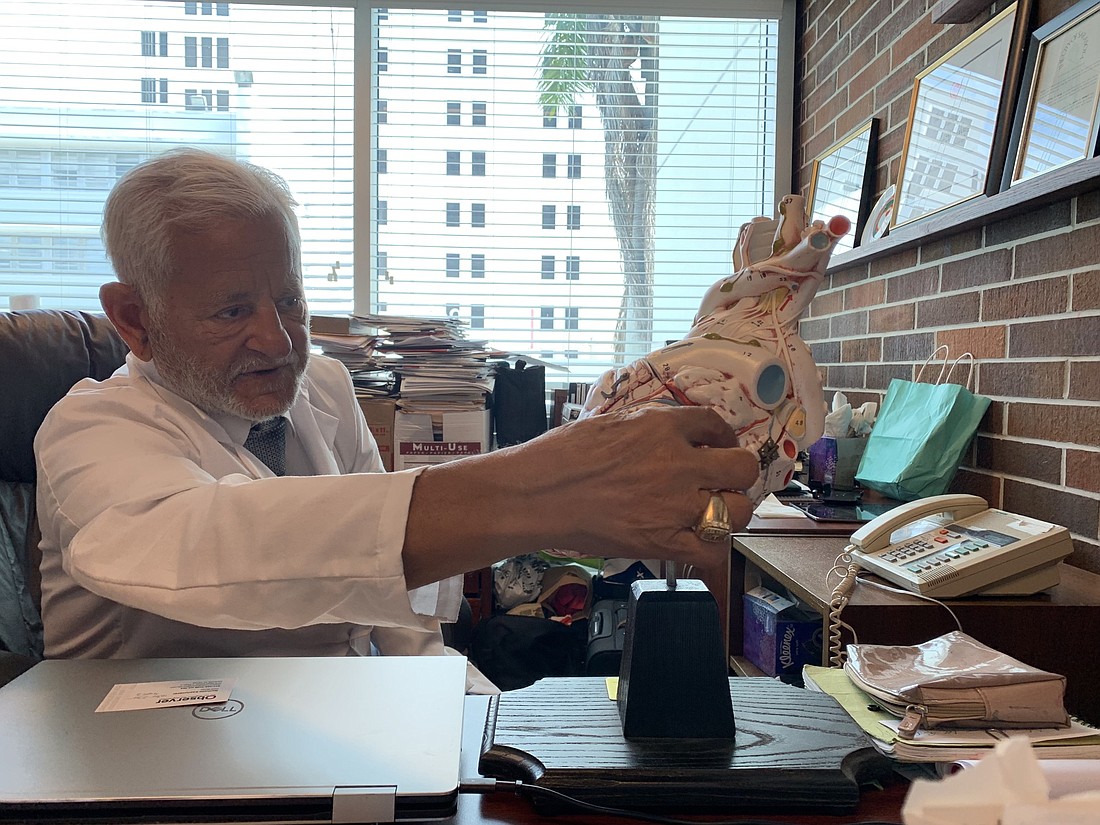- November 21, 2024
-
-
Loading

Loading

You have chest pain. Breathing has been harder. It feels like an elephant is sitting on your chest. Your doctor says you have angina — a symptom of a lack of blood flow to your heart.
So you look into it. Medication helps, and so can surgeries to open the arteries like angioplasty or a bypass. Exercise helps, but it’s hard to walk more than a short time right now.
"It’s because your heart muscle is not getting enough blood and oxygen, and that’s because you have a blocked or narrowed artery," said Dr. Clayton Bredlau, a cardiologist at the Heart and Vascular Center of Sarasota.
You should look into these things — they’re proven to work. But there’s also another route that includes a heart therapy called enhanced external counterpulsation, which uses inflating and deflating cuffs to increase the return of blood to the heart.
This therapy originated in China and has been common there since the 1960s but began gaining usage in the 1990s in the U.S. It’s not for everyone, Bredlau said, but for the right candidates, it can work wonders.
For people whose medicine isn’t quite doing the trick or for those who aren’t candidates for heart surgery, rounds of EECP can mitigate symptoms and increase tolerance for exercise. EECP lowers the amount and frequency of medicine usage for those with angina, as well as the number of angina episodes, Bredlau said.
A typical schedule would be five one-hour treatments a week for seven weeks, Bredlau said. Medicare pays for the therapy once a year for qualifying patients, though the effects last for about two years.
Surgery, like angioplasty or stents, is the typical route recommended by physicians, but it isn’t always right for everyone.
“With complete blockages, it’s very, very hard to get a stent in because [it has often] been blocked for very long time,” Bredlau said.
In comes a noninvasive therapy. Patients with a high risk of cardiac events can turn to EECP to reduce their symptoms of heart disease — but not to cure it because there is no cure for heart disease, said Dr. Mahfouz El Shahawy, a cardiologist at the Cardiovascular Center of Sarasota. These procedures just release symptoms, not prolong life, he said.
At the Heart and Vascular Center of Sarasota, the therapy creates natural heart artery bypasses by turning to collateral arteries to make them bigger, and it improves the heart health of patients by allowing more blood and oxygen to reach the heart muscle, Bredlau said.
“We do it in people that have blocked arteries and blocked bypasses,” Bredlau said.
Typically, those with angina pectoris are taking medications daily, Shahawy said. Angina medication has gotten more sophisticated in the past couple decades, Shahawy said, which is why EECP isn't used quite as much anymore, though it's still prevalent in China. Now medication consists of a beta blocker, calcium channel blocker and nitroglycerin, Shahawy said. The body naturally produces nitroglycerin through exercise and then turns it into nitric oxide, which increases blood flow. This is why exercising more helps mitigate angina, Shahawy said.
“[EECP] kind of simulates exercise,” Bredlau said. “It increases cardiac output two to three times the normal rate, so it’s kind of like you’re running.”
That’s good news for people with congestive heart failure or refractory angina because it allows them to do more with less pain, which leads to a healthier heart. Exercise stress tests get better, and 85% of people who use the therapy see a reduction in their symptoms, Bredlau said.
If you don't have heart disease but want to create a healthy heart for your future, Shahawy reminds people that “an ounce of prevention is better than pounds of cure.” To prevent heart disease, especially if there’s a history in your family, you should stop smoking, drink less and exercise more — generally, live a healthy life.
“You should concentrate more on cardiac prevention,” Shahawy said. “Exercise is your best pill.”
SIDEBAR:
First, you have to find a clinic with the equipment — such as the Heart and Vascular Center of Sarasota. After you make your schedule, you’ll start getting the therapy. Three sets of cuffs go around your lower legs near your calves, just above the knee, and around the buttocks and upper thigh.
The lower cuff starts inflating first, then the next and so on. The idea is to use these cuffs to return blood to the heart during diastole — when it’s relaxed. This increases blood returned to the heart and ups the amount of oxygen your heart has to use. As they deflate, the blood returns back from the heart. It’s not opening up your arteries in the same way angioplasty does, by using a small balloon in surgery to “inflate” the artery, but it’s forcing blood through them.